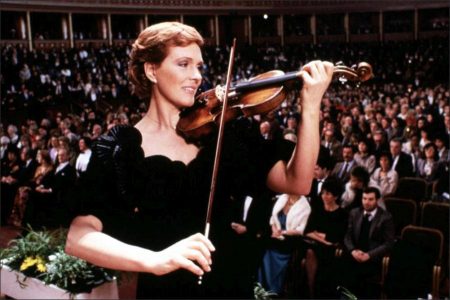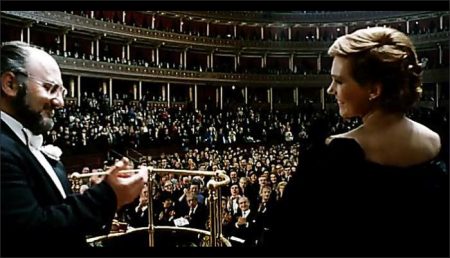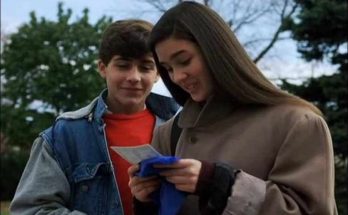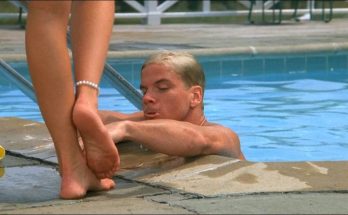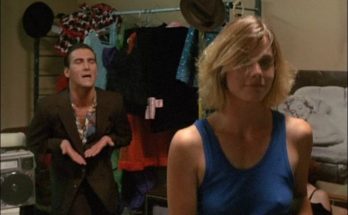Duet for One movie storyline. Stephanie Anderson, a world-famous violinist, becomes unable to play because of multiple sclerosis. A depressed psychiatrist she sees is unable to help with her rage and frustration. Her star pupil, realising he will learn nothing more, leaves her. Her husband departs with his young secretary, and her accompanist dies. Her fierce desire to be alone in her pain alienates everybody except her faithful maid.
She gives all her musical effects to a totter (an itinerant scrap merchant), who she asks into her bed as well. Watching a videotape of a concert triumph, she takes an overdose but the maid breaks in to try and save her. In an epilogue, which may be a dream, the psychiatrist has become a friend while her ex-husband and former pupil come back to see her, as does the ghost of her accompanist.
Duet for One is a 1986 British drama film adapted from the play, a two-hander by Tom Kempinski, about a world-famous concert violinist named Stephanie Anderson who is suddenly struck with multiple sclerosis.[2] It is set in London and directed by Andrei Konchalovsky. The story is based on the life of cellist Jacqueline du Pré, who was diagnosed with MS, and her husband, conductor Daniel Barenboim, and only marginally fictionalized.
Review for Duet for One
Lead: IT took half a dozen extra characters and a very large tree to open up Tom Kempinski’s two-character play ”Duet for One” and bring it to the screen. But the focus is still Stephanie Anderson, a brilliant violinist (modeled, to some extent, on the cellist Jacqueline Du Pre) who is married to a celebrated conductor and has multiple sclerosis.
IT took half a dozen extra characters and a very large tree to open up Tom Kempinski’s two-character play ”Duet for One” and bring it to the screen. But the focus is still Stephanie Anderson, a brilliant violinist (modeled, to some extent, on the cellist Jacqueline Du Pre) who is married to a celebrated conductor and has multiple sclerosis. Stephanie’s illness becomes an occasion for her to re-examine her life as she describes it to Dr. Louis Feldman (Max von Sydow), a psychiatrist who is something of a friend and fan. It also becomes an occasion for Mr. Kempinski to elicit the audience’s pity in a far too easy and automatic way.
”Why should I die such a horrible death?” Stephanie asks in Andrei Konchalovsky’s film ”Duet for One,” which opens today at Cinema I. ”Was I so terrible? Was this music so terrible?” A good deal of the screenplay, which is by Mr. Kempinski, Mr. Konchalovsky and Jeremy Lipp, is as disingenuous as that, and as needlessly coy.
But ”Duet for One,” for all its sogginess and contrivance, is a compelling vehicle, particularly for a star who fits the material as well as Julie Andrews does. The idea of a Julie Andrews role these days hardly conjures up the chipperness of her early career, since Miss Andrews has lately been effective as a quietly exasperated, somewhat queenly heroine reluctantly facing up to mortality. Here, even more so than in ”That’s Life!,” Miss Andrews finds the opportunity to draw on previously underused aspects of her talent. Her performance is often a good deal better than the material.
Surrounding Stephanie, and providing her with an opportunity to confront separate aspects of her life, are her husband, David Cornwallis (Alan Bates), and a household full of friends and retainers. There is the hot-headed Constantine Kassanis (Rupert Everett), Stephanie’s violin protege and a passionate young man who cannot help speaking the truth; Constantine makes Stephanie face up to the waning of her musical abilities.
There is Penny Smallwood (Cathryn Harrison), the pretty secretary on whom David is growing more and more dependent as his wife drifts away; because of Penny, Stephanie must deal with her feelings of jealousy, too. There is even a maid named Anya (Macha Meril) with whom Stephanie can discuss sexual frustration.
Finally, as Stephanie grows angrier and more self-destructive, there is a junkman named Totter (Liam Neeson) with whom she has an affair. It’s typical of both the material’s bluntness and Mr. Konchalovsky’s that the junkman has a wife who dresses garishly and that he spends evenings singing in a neighborhood pub. (As Stephanie begins debasing herself, the music on the soundtrack descends rather snobbishly to include a pop song and a big-band number.) All these developments are terrifically tidy, as is the story’s ending. They do little to alleviate the essential talkiness of the material.
Miss Andrews is much more powerful a presence than anyone else in the cast, though Mr. Everett has a few amusingly spirited moments as Constantine. Though the material is episodic and fragmented, Miss Andrews is forceful and affecting enough to keep it together. Mr. Konchalovsky, working at a much less feverish pitch than he did with ”Runaway Train,” gives the film a stately look befitting its refined and affluent heroine, and does better in establishing her external surroundings than her inner state.
Duet for One (1986)
Directed by: Andrey Konchalovskiy
Starring: Julie Andrews, Alan Bates, Max von Sydow, Rupert Everett, Margaret Courtenay, Cathryn Harrison, Sigfrit Steiner, Liam Neeson, Siobhan Redmond, Janette Newling
Screenplay by: Tom Kempinski
Production Design by: John Graysmark
Cinematography by: Alex Thomson
Film Editing by: Henry Richardson
Costume Design by: Evangeline Harrison
Art Direction by: Reg Bream, Steve Cooper
Music by: Michael Bishop
Distributed by: Golan-Globus Productions
Release Date: December 25, 1986
Visits: 108
